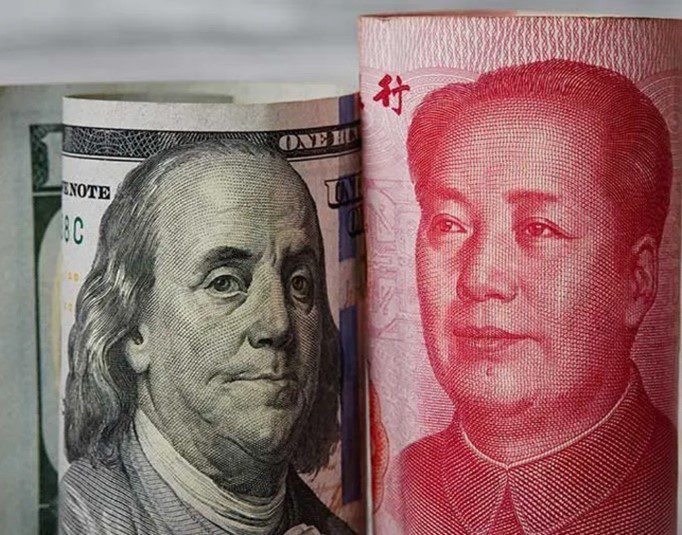The so-called “golden tax system” in China separates the country’s tax system from the rest of the world. With a rigorous and centralized data system, China operates within a tax system that allows the authorities to manage the issuance of all invoices nationwide. On the other hand, the centralization of data is also what makes the country a forerunner in building an economic environment that is beyond digital.
Read our previous article on Beyond Digital – AI, Blockchain & Pilot Zones in China
The golden tax system (GTS) ensures that companies remain tax compliant as their tax activities could be monitored through a centralized invoicing system. Read more and find out how this works.
What is China’s Golden Tax System?
China’s State Taxation Administration (STA) developed the golden tax system to enable an integrated value-added tax (VAT) monitoring system that can be used to register, check, and collect VAT. Thus, all VAT-registered businesses operating in mainland China should operate within the GTS. As they do so, they are required to issue VAT invoices, make VAT calculations, and comply with statutory tax reporting. The system, as a whole, encompasses the following aspects of invoicing:
- Different applicable VAT rates include 13%, 9%, 6%, 3%, and 0%;
- Special VAT invoices called “fapiao”;
- The unique number assigned to invoices for every valid VAT transaction;
- The physical input and output VAT invoices issued and received by registered VAT businesses;
- The format of those invoices as mandated by the tax bureau authorities;
- The terminal used for VAT found at the company;
- Another terminal that belongs to the tax authority connected through the internet;
- VAT calculations, including VAT data validation and verification; and
- Filing periodic returns and supplementary forms.
Preparation
When issuing an invoice, the company connects its terminal to the invoicing section of the GTS. Thus, for every invoice transaction, the company sends a copy of the invoice to the tax bureau through the GTS (via the internet). Finally, the tax authority terminal can receive and compare the company terminal copies and control the VAT invoices processed by the company.
Preparation under the GTS, in a nutshell, involves extracting raw VAT data from a single source or various source systems. Persons authorized would then analyze and adjust reportable numbers to correct any errors. This can be done manually in the form of a reconciliation, which could take a very long time. The totals are then placed in the correct return boxes before submission. Specific system tools or well-made excel spreadsheets may record these processes systematically to maintain the final reportable VAT numbers.
Purpose
China’s tax authorities designed the GTS to prevent counterfeiting and enable full control of invoice data. Through the GTS, tax inspectors can directly examine the authenticity of special VAT invoices (fapiaos) which normally dictates tax liabilities. Therefore, the primary aim of the system is to avoid fraud and ensure that businesses are compliant with the law.
Read more about Electronic Invoice System in China and Current Developments
Considered as “one of the most sophisticated return submission processes in the world”, the GTS puts companies to the test particularly those without the proper tools to aid in the process. According to auditors, some of the most typical errors they encounter include the wrong application of rates, omission of VAT transferred out when it is non-creditable, and wrong reportable amounts.
Opportunities and challenges of the Golden Tax System
Challenges presented
If companies wish to reach a correct amount by the VAT submission due date, they might forgo manual itemized reconciliation of the VAT transactions. Instances arise where companies might struggle to get the right reportable VAT. If not corrected, it might expose them to tax audits or having to pay more tax than the computed amount just to be prudent. To prevent this from happening, it would be more conservative for companies to be able to get right the original data of input, rather than checking for errors during reconciliation. This is where accounting and management software may improve tax reporting.
Opportunity to use accounting software
Accounting software tools allow companies to use several functions to pave the way for correct VAT reporting. These might include:
- Automatically importing expenses and vendor bills using OCR and artificial intelligence (AI) technology that recognizes data and inputs them accurately;
- Classifying transactions by their proper tax codes instead of general ledger (GL) codes;
- Tax localization and easy integration into Chinese accounting software;
- Transferring the VAT invoices information directly from the software to the Golden Tax System; and
- Easy and convenient first-level validation during data input.
A Cloud-based, digital accounting software such as Kwikdroid can accomplish all the above functions with ease. It uses AI-powered and OCR technology for fapiao integration. After taking a photo of the fapiao, it can be uploaded into the Kwikdroid system. Kwikdroid will analyze and extract data to automatically store and create electronic invoices. This AI technology will allow for accuracy during data input. Kiwkdroid also has a built-in chat system that can enable interaction with an accountant. Hence, a manual reconciliation would be a breeze if 100 percent accuracy is accomplished and all business needs are attended to.
Conclusion
Chinese VAT depends on the GTS. As complicated as the GTS might be, several tools and expert practitioners are available to aid in reaching the goal of 100 percent accuracy in VAT reporting and on-time submission of reports. Since everything in the GTS must be factual, errors will subject companies to be red-flagged. However, with the right information and help, all these complicated aspects can come together smoothly, hopefully without the hassle of exposure to tax audits and a significant impact on cash flows.
Contact us
S.J. Grand’s tax and accountancy services provide advisory on China’s tax, accounting standards, and business regulatory environment as well as assist in annual closing for foreign individual workers and enterprises in China. Contact us to get you started.
If you are interested in Kwikdroid, contact us or go to our Kwikdroid page to request a demo and see the prices and packages we offer.







